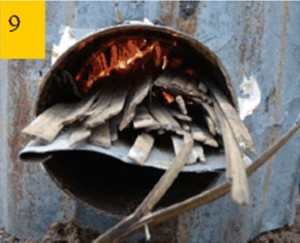By HAZEL P. VILLA
AFTER VERA Files featured on Yahoo! a story on a stove innovation that can be built in less than two hours with minimal skills, tools and materials from typhoon debris, requests were made to post the actual steps.
Development worker Joshua “Jed” B. Guinto, who made the innovation from the basic design of the rocket stove by Dr. Larry Winiarski of the Aprovecho Institute in Oregon, has adjusted the materials to include old metal roof with clay, soil and rice husk as the insulating layer.
Called the Contod Rocket Stove, Guinto says the stove can be made out of tin metal sheets such as old metal roof (yero), 30 liters carbide canisters or even biscuit container of equivalent size plus three pieces of one-liter tin cans (Del Monte pineapple cans are of the right size). It will also require clay or soil and other biomass materials such as rice husks and coco fiber (bunot ng niyog) for the insulating layer.
The efficiency of the rocket stove comes from the right combination of fuel, air and heat. It is important that the wood sticks fuel are small and air is flowing freely beneath them. It is only partly pushed to the burner chamber so as not to create too much smoke. The long fuel shelf preheats the incoming fuel and air. The high chimney serves as to pull up fresh air and at the same time burn the smoke without losing heat because of the insulating effect of the clay-rice hull mix. The extra high skirt protects the heat from being blown off and improves the contact of the flames to the pot. The hot skirt serves to dry the next fuel stick.
The steps to making the Contod Rocket Stove, as shared by Guinto, are shown below:
Steps 1 and 2. Join two containers of Del Monte Pineapple juice cans or any similar container in a T-junction. One hole would serve as the fuel chamber and the other end as the chimney.
Step 3. Cut a metal roof to the size which will allow the kettle to cover the sides of the pot. Flatten the metal by pounding with a big piece of wood. Make a hole on the side to fit in the fuel chamber.
Step 4. Join the ends of the metal roof. Fold one inch at both ends in opposite directions and lock them together by carefully hammering. Lock the joint together by punching a hole at both ends and fix with a piece of wire.
Step 5. Assemble the T joint inside the center of the cylinder. Put on more one liter tin can on top of the chimney.
Step 6. Prepare a mixture of one part soil or better yet, clay to one part rice hull and one part coco fiber.
Step 7. Fill the space between the T joint and the cylinder and press the mixture hard.
Step 8. Put three pieces of stones with the size enough to have the pot about 1.2 centimeters from the chimney.
Step 9. Cut and flatten one more piece of metal sheet. This which will serve as the platform of the fuel sticks inside the fuel chamber without blocking the fire chamber.
Step 10. Prepare about ten small tin cans of sardines. Cut open both sides and attach them to the uppermost side of the stove. This will serve as holder of the wet fuel sticks which can be dried while cooking.









